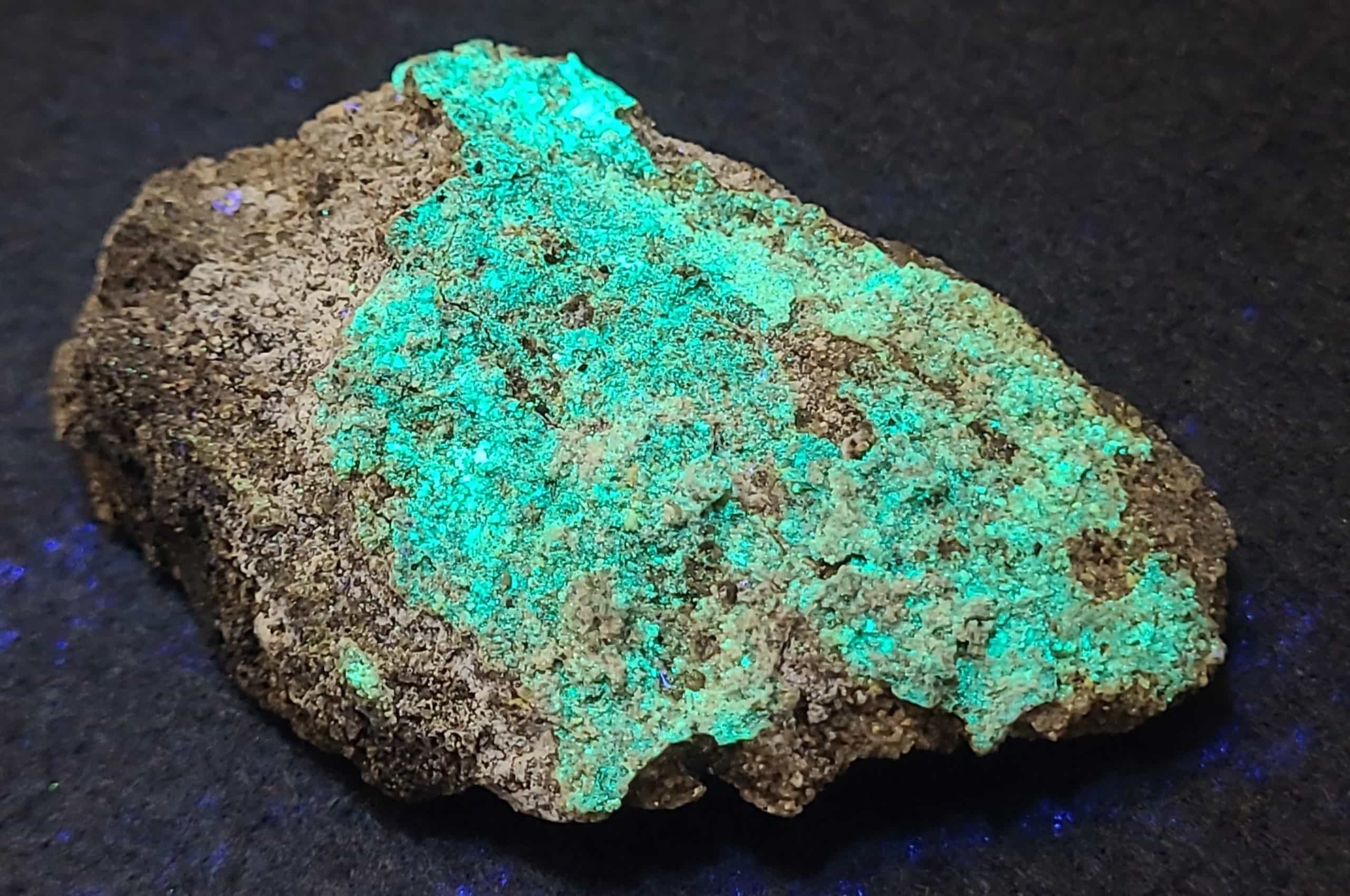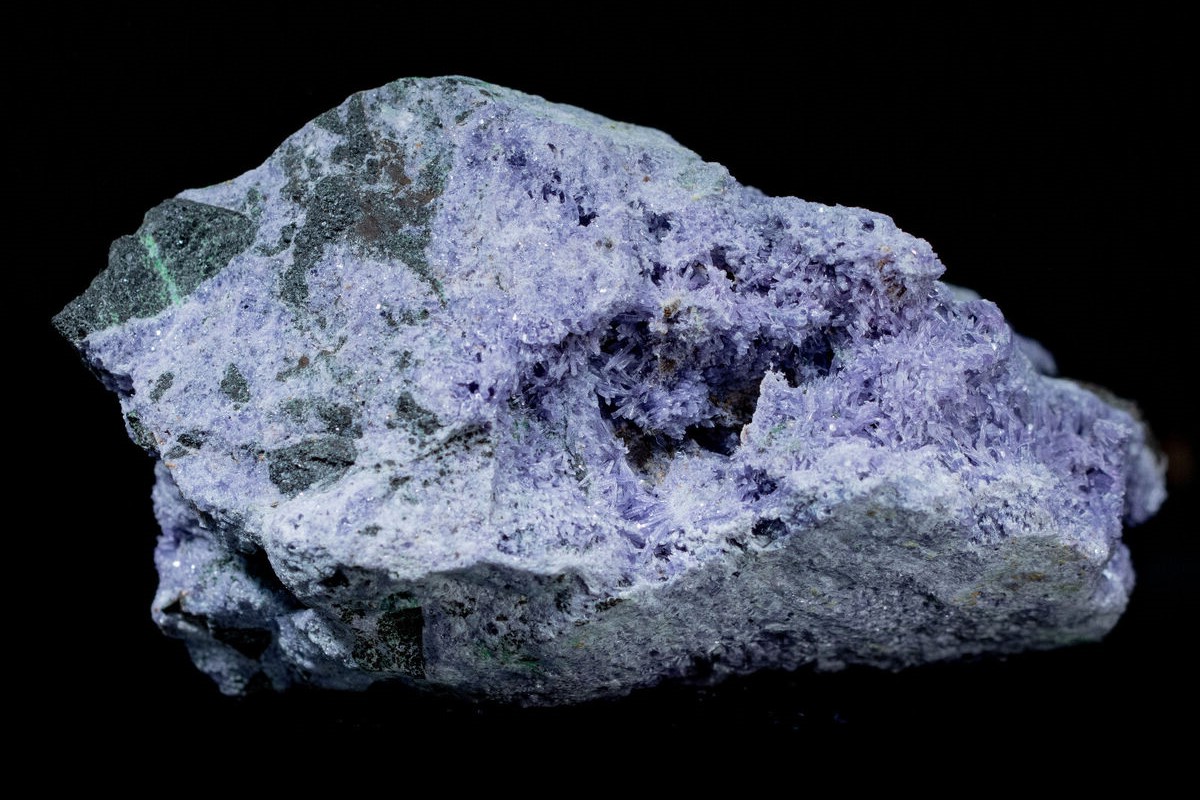
What makes Andersonite so special? Andersonite is a rare uranium carbonate mineral with a striking bright green to yellow-green color. First described in 1948 by Charles Alfred Anderson, this mineral is named in his honor. Its chemical formula, Na2Ca(UO2)(CO3)3·6H2O, reveals its complex composition, including sodium, calcium, uranium, and carbonate. Andersonite crystallizes in the trigonal system and often forms rhombohedral crystals. It is highly fluorescent under ultraviolet light, glowing a vivid pale green to yellow-green. However, its radioactivity due to uranium content requires careful handling. Found in the oxidized zones of uranium-bearing ore deposits, Andersonite is a prized specimen for collectors and researchers alike.
Key Takeaways:
- Andersonite, a rare mineral, was discovered by geologist Charles Alfred Anderson in 1948. Its unique properties and radioactive nature make it a prized specimen for collectors and a subject of scientific research.
- Andersonite's bright green to yellow-green color, fluorescent properties, and association with uranium deposits make it a fascinating and valuable mineral for collectors and researchers studying Earth's geological processes.
Discovery and Naming
Andersonite is a rare and intriguing mineral with a rich history. Let's dive into its discovery and naming.
-
Discovery: Andersonite was first described in 1948 by Charles Alfred Anderson, an American geologist who worked with the United States Geological Survey (USGS) at the time.
-
Name Origin: The mineral is named after Charles Alfred Anderson, who played a crucial role in its discovery and description.
Chemical Composition and Classification
Understanding the chemical makeup and classification of Andersonite helps us appreciate its unique properties.
-
Chemical Formula: The chemical formula for Andersonite is Na2Ca(UO2)(CO3)3·6H2O, which indicates its composition as a hydrated sodium calcium uranyl carbonate.
-
Category: Andersonite belongs to the category of carbonate minerals, which are a group of minerals that contain the carbonate ion (CO3^2-).
-
IMA Symbol: The International Mineralogical Association (IMA) symbol for Andersonite is Anr.
-
Strunz Classification: In the Strunz classification system, Andersonite is classified under 5.ED.30, which categorizes it as a uranium carbonate mineral.
Crystal Structure and Physical Properties
The crystal structure and physical properties of Andersonite make it a fascinating subject for study.
-
Crystal System: Andersonite crystallizes in the trigonal crystal system, but its crystals often exhibit hexagonal scalenohedral (3m) symmetry.
-
Space Group: The space group of Andersonite is R3m, which is characteristic of its trigonal crystal structure.
-
Unit Cell: The unit cell dimensions for Andersonite are a = 18 Å and c = 23.83 Å, with a Z value of 18, indicating the number of formula units per unit cell.
-
Color: Andersonite typically exhibits a bright green to yellow-green color, although it can also appear in other shades depending on the specific deposit it is found in.
-
Crystal Habit: The crystals of Andersonite often form rhombohedra, which are typically flattened and pseudocubic in shape. It can also occur as crystalline crusts or granular aggregates.
-
Mohs Hardness: Andersonite has a Mohs hardness of 2.5, which is relatively soft compared to other minerals.
-
Luster: The luster of Andersonite is vitreous to pearly, giving it a glassy appearance that seems to glow under certain conditions.
-
Diaphaneity: Andersonite is transparent to translucent, allowing light to pass through it to some extent.
-
Specific Gravity: The specific gravity of Andersonite is approximately 2.8, which is slightly higher than water.
Optical and Fluorescent Properties
Andersonite's optical and fluorescent properties add to its allure.
-
Optical Properties: Andersonite exhibits uniaxial (+) optical properties, meaning it has a single optical axis. The refractive indices are nω = 1.520 and nε = 1.540, with a birefringence of δ = 0.020.
-
Pleochroism: Under polarized light, Andersonite shows visible pleochroism, where the color changes depending on the orientation of the crystal. It appears colorless in one direction and light yellow in another.
-
Ultraviolet Fluorescence: When exposed to ultraviolet light, Andersonite specimens often glow a bright pale green to yellow-green color, making them highly fluorescent.
Solubility and Radioactivity
These properties make Andersonite both fascinating and challenging to handle.
-
Solubility: Andersonite is soluble in water, which means it can dissolve in aqueous solutions. This property requires that samples be stored in dry conditions to prevent degradation.
-
Radioactivity: Andersonite is radioactive, containing uranium as part of its chemical composition. This makes it a significant concern for handling and storage, as it exceeds the 70 Bq/gram threshold for radioactive materials.
Occurrence and Associations
Where Andersonite is found and what it is often found with can tell us a lot about its formation.
-
Occurrence: Andersonite is found in the oxidized zone of uranium-bearing polymetallic ore deposits. It can also occur as an efflorescent crust on the walls and timbers of uranium mines.
-
Associated Minerals: Andersonite often occurs with other minerals such as schrockingerite, bayleyite, schwarzites, boltwoodite, liebigite, and gypsum.
-
First Described Location: The first recorded occurrence of Andersonite was in the Hillside Mine near Bagdad in the Eureka District of Yavapai County, Arizona.
-
Rarity: Andersonite is considered a rare mineral, making it highly sought after by collectors and researchers in the field of mineralogy.
Formation and Geological Significance
Understanding how Andersonite forms and its geological significance provides insights into Earth's processes.
-
Post-Mine Origin: In addition to its natural occurrence in ore deposits, Andersonite can also be found in post-mine environments, such as efflorescent crusts on mine walls and timbers.
-
Hydrothermal Deposits: Andersonite is associated with hydrothermal polymetallic deposits, which are formed through the interaction of hot water and minerals deep within the Earth's crust.
-
Geological Significance: The presence of Andersonite in geological formations provides valuable information about the conditions under which these deposits formed. Its association with other minerals helps in understanding the complex processes involved in mineralization.
Collectibility and Research
The rarity and unique properties of Andersonite make it a prized specimen for collectors and researchers alike.
-
Collectibility: Due to its rarity and unique properties, Andersonite is highly prized among mineral collectors. Specimens are often sought after for their fluorescent properties and distinctive color.
-
Scientific Research: Andersonite has been the subject of various scientific studies, particularly in the fields of mineralogy and geochemistry. Researchers continue to study its properties to better understand the geological processes that form such minerals.
-
Handling and Storage: Given its radioactivity, handling and storing Andersonite requires special precautions. Samples must be stored in dry conditions to prevent dissolution and should be handled by trained professionals to minimize exposure to radiation.
Andersonite: A Rare Gem in Mineralogy
Andersonite, with its bright green to yellow-green color and unique fluorescence, stands out in the world of minerals. Discovered in 1948 and named after Charles Alfred Anderson, this rare uranium carbonate mineral has a lot to offer. Its chemical formula Na2Ca(UO2)(CO3)3·6H2O and trigonal crystal system make it a fascinating subject for study. Despite its soft Mohs hardness of 2.5, Andersonite's radioactivity and solubility in water require careful handling. Found in the oxidized zones of uranium-bearing ore deposits, it often appears alongside minerals like schrockingerite and bayleyite. Collectors prize it for its rarity and striking appearance. Whether you're a mineral enthusiast or a geology student, Andersonite offers a glimpse into the complex processes that shape our planet. Handle with care, and you'll have a piece of Earth's history in your hands.
Frequently Asked Questions
Was this page helpful?
Our commitment to delivering trustworthy and engaging content is at the heart of what we do. Each fact on our site is contributed by real users like you, bringing a wealth of diverse insights and information. To ensure the highest standards of accuracy and reliability, our dedicated editors meticulously review each submission. This process guarantees that the facts we share are not only fascinating but also credible. Trust in our commitment to quality and authenticity as you explore and learn with us.


